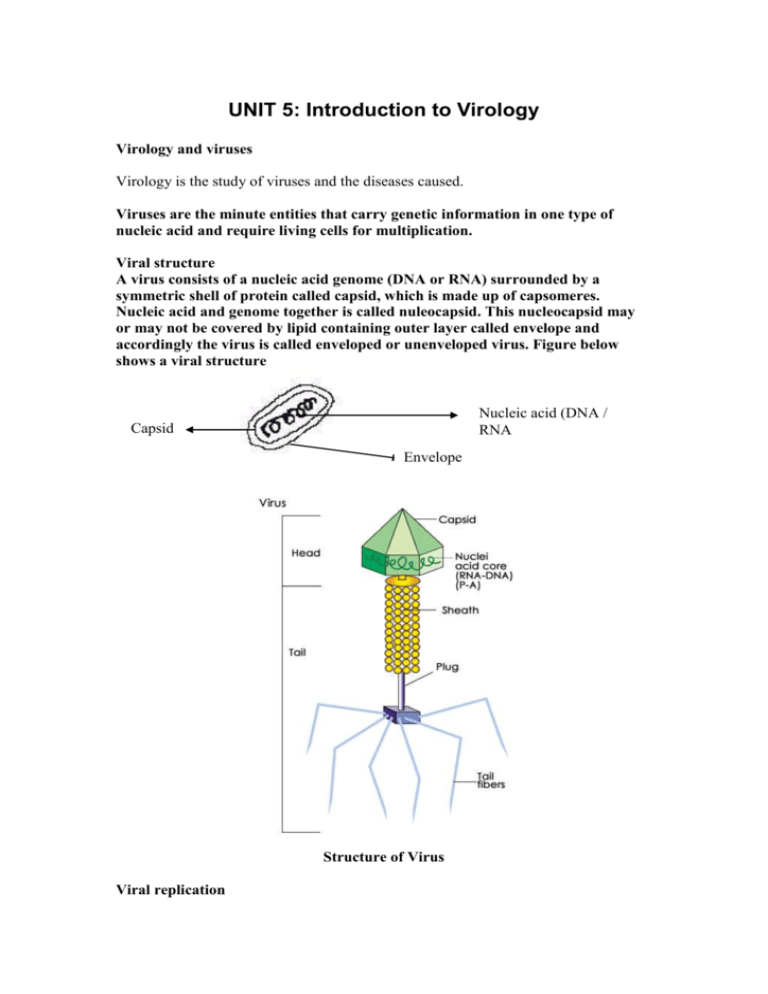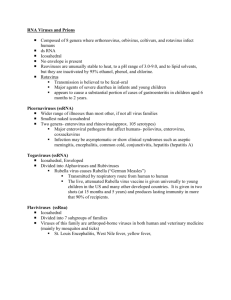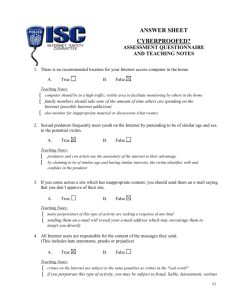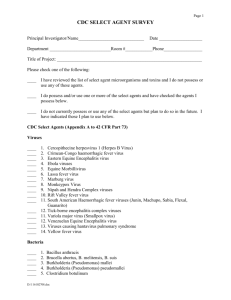UNIT 5: Introduction to Virology
advertisement

UNIT 5: Introduction to Virology Virology and viruses Virology is the study of viruses and the diseases caused. Viruses are the minute entities that carry genetic information in one type of nucleic acid and require living cells for multiplication. Viral structure A virus consists of a nucleic acid genome (DNA or RNA) surrounded by a symmetric shell of protein called capsid, which is made up of capsomeres. Nucleic acid and genome together is called nuleocapsid. This nucleocapsid may or may not be covered by lipid containing outer layer called envelope and accordingly the virus is called enveloped or unenveloped virus. Figure below shows a viral structure Nucleic acid (DNA / RNA Capsid Envelope Structure of Virus Viral replication The process by which virus multiply in the host cell is called replication. After the penetration into the host cell virus releases its nucleic acid into the cytoplasm, which multiplies using the materials of the host cell producing large number of viruses. Figure below shows viral replication (bacteriophage) Various phases in the replication of virus are: 1. Initiation phase: Attachment: virus attaches on the animal cell Penetration: cell membrane is lysed and the virus penetrate into the cell Uncoating: the capsid is dissolved and the genetic material of the virus is introduced into the cell. 2. Replication phase: DNA or RNA synthesis: as per the nucleic acid content of the particular virus there is synthesis of viral nucleic acid within the infected animal cell. Protein synthesis: similarly the viral protein required for the formation of viral capsid are synthesised in the infected cell. 3. Release phase: Assembly: the vir al particles, nucleic acid and the capsid assemble together resulting into production of new virion Maturation: after the assemble the virion mature and exit from cell after the lysis of cell to infect new cells. Classification of virus Ether sensitivity Based on the sensitivity to ether virus can be said to be ether sensitive or ether resistant. Ether sensitive viruses are those that get denatured when in contact with ether and ether resistant are those viruses that do not get denatured. Envelope Based on the presence of envelope or not virus are said to be either enveloped if it has envelope or unenveloped if there is no envelope. Viruses are classified into families and genera based on the nucleic acid present in genome, size, structure, biochemical characteristics and mode of replication. Two major groups of viruses are DNA virus and RNA virus. Based on the type of genomic material, viruses are classified as: DNA viruses 1. Adenoviridae. Viruses in this family are unenveloped and ether resistant. 2. Herpesviridae. Viruses in this family are unveloped. Infectious bovine rhinotracheitis belong to this group of virus. 3. Papovaviridae. Viruses in this family are unenveloped and ether resistant. 4. Parvoviridae. Viruses in this family are unenveloped and ether resistant. 5. Poxviridae. Viruses in this family are large and covered by a complex outer cover. RNA viruses 1. Arenaviridae. Viruses in this family are associated with human diseases. 2. Bunyaviridae. Viruses in this family are enveloped and ether resistant. Rift valley fever virus is the member of this family. 3. Coronaviridae. Viruses in this family are enveloped and ether sensitive. Avian bronchitis virus, transmissible gastroenteritis virus of swine and bovine coronavirus are the members of this family. 4. Orthomyxoviridae. Influenza virus belongs to this group of virus. 5. Paramyxoviridae. Viruses of this family are enveloped and ether sensitive. Rinderpest virus belongs to this family. 6. Picornaviridae. Viruses of this family are small and enveloped. FMD virus is the member of this family. 7. Reoviridae. Viruses in this family are unenveloped and ether resistasnt. Bluetongue virus belongs to this family. 8. Retroviridae. Viruses in this family are enveloped. 9. Rhabdoviridae. Viruses in this family are bullet shaped and enveloped. Rabies virus and vesicular stomatitis virus are the members of this family. 10. Togaviridae. Viruses in this family are enveloped and ether sensitive. Bovine viral diarrhoea virus belongs to this family. Viruses and diseases Poxviridae • DNA virus, 200mµ x300mµ • Usually enveloped but variable. • Usually ether resistant. • Diseases in animals: smallpox and vaccinia. Cowpox, sheep pox, Swinepox, monkey pox, etc Avian poxes in turkey, fowl, pigeons and canaries Herpesviridae • DNA virus, enveloped • 110 mµ cubic symmetry • Ether sensitive • Diseases in animals: Pseudorabies, Infectious Rhinotracheitis, Malignant catarrh, Laryngotracheitis Papovaviruses • DNA virus • 40mµ to 50 mµ, cubic symmetry • Ether resistant, • Non enveloped • Diseases in animals: Common warts Bovine papilloma Canine oral papilloma Rabbit oral papilloma Rabbit papilloma Polyoma Genital papilloma of swine Adenoviruses • DNA virus • 70 mµ to 80 mµ cubic symmetry • Ether resistant • Nonenveloped • In animals:Canine hepatitis Bovine adenovirus Simian adenovirus Avian adenovirus Arboviruses RNA virus 40-50 mµ Ether sensitive, enveloped Usually vector transmitted In animals: Grp A: Equine encephalitis Grp B: Louping ill Yellow fever Rift valley fever Dengue Ungrouped: • California encepahlitis • African Horse Sickness’ • Blue tongue Myxo viruses • RNA, 80 to 200 mµ • Helical symmetry, enveloped • Ether sensitive • Affinity for mucoproteins Coronaviridae Enveloped Ether sensitive Diseases in animals Avian bronchitis virus Transmissible gastroenteritis virus of swine Bovine coronavirus Orthomyxoviridae RNA virus Ether sensitive Helically symmetrical Enveloped Causes influenza Paramyxoviridae RNA virus







